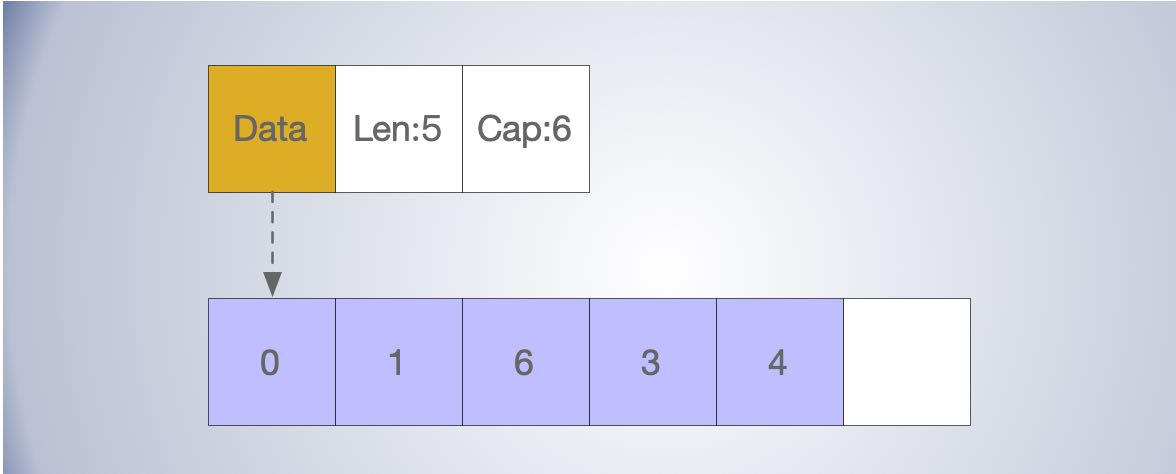数组&切片
数组&切片
[TOC]
数组
数组应该是最长用的数据结构了,数组是由相同类型元素的集合组成。数组要求在内存中分配一片连续的内存空间,相比链等不连续的数据结构,对CPU更加的友好,通过索引可以在 O(1) 的时间复杂度快速访问。
数组最常见的是一维数组,多维数组在一些场景场景,如图形计算,有会用到。
数组在大小在初始化之后,通常无法再改变大小。
不同长度的数组,通常属于不同的类型。
数组的类型是由元素类型 Elem 和数组的大小 Bound,共同构成了数组的,类型在编译期间通过 cmd/compile/internal/types.NewArray 生成。
// cmd/compile/internal/types.NewArray
// NewArray returns a new fixed-length array Type.
func NewArray(elem *Type, bound int64) *Type {
if bound < 0 {
Fatalf("NewArray: invalid bound %v", bound)
}
t := New(TARRAY)
t.Extra = &Array{Elem: elem, Bound: bound}
t.SetNotInHeap(elem.NotInHeap())
return t
}
切片
切片可以算是动态数组,长度不固定,可以随着元素的增加自动扩容。
与数组不同的是,切片在编译期间生成的类型,不包括长度。
// cmd/compile/internal/types.NewSlice
// NewSlice returns the slice Type with element type elem.
func NewSlice(elem *Type) *Type {
if t := elem.Cache.slice; t != nil {
if t.Elem() != elem {
Fatalf("elem mismatch")
}
return t
}
t := New(TSLICE)
t.Extra = Slice{Elem: elem}
elem.Cache.slice = t
return t
}
内存布局
与 map 相比,切片的数据结构就简单很多了,只有:
- 指向底层数组的指针;
- 当前长度 len;
- 当前 slice 的 容量cap。
// runtime/slice.go
type slice struct {
array unsafe.Pointer
len int
cap int
}
在运行时,也可以有反射包的 reflect.SliceHeader 结构体表示.
type SliceHeader struct {
Data uintptr
Len int
Cap int
}
在存储上,切片相当于在一片数组上,增加了基指针,长度,容量从而实现了动态变化的属性。
- Data 指针,未必是从数组的起始位置开始的。
- 当底层数组内存不足时,追加元素会自动扩容。

初始化
切片主要有三种初始化方式:
- 基于现在的数组或切片的片段初始化切片; 这种方式修改新切片元素,会影响原数组(切片) 的元素。
- 字面量初始化;
- 使用关键字 make;
// 下表截取
slice1 := arr[0:3]
slice1 := slice1[0:5]
// 字面量初始化
slice1 := []int{1, 2, 3, 4}
// make 关键字初始化
slice := make([]int, 0, 6)
// new
slice := new([]int)
通过 make 关键字的会被编译转换为 runtime.makeslice 实现,溢出判断,然后调用 runtime.mallocgc 分配内存:
func makeslice(et *_type, len, cap int) unsafe.Pointer {
mem, overflow := math.MulUintptr(et.size, uintptr(cap))
if overflow || mem > maxAlloc || len < 0 || len > cap {
mem, overflow := math.MulUintptr(et.size, uintptr(len))
if overflow || mem > maxAlloc || len < 0 {
panicmakeslicelen()
}
panicmakeslicecap()
}
return mallocgc(mem, et, true)
}
使用new关键字,会被编译器转化为 runtime.newobject
func newobject(typ *_type) unsafe.Pointer {
return mallocgc(typ.size, typ, true)
}
扩容
当容量不足时,切片就需要扩容,
- 如果 cap <= 1024 , 会加倍的扩张存储空间;
- 如果 cap > 1024 , 就按照 1.25 的增长因子进行扩容。
func growslice(et *_type, old slice, cap int) slice {
...
newcap := old.cap
doublecap := newcap + newcap
if cap > doublecap {
newcap = cap
} else {
if old.len < 1024 { // 小于 1024 , 会加倍的扩张存储空间, 否则按 1.25 倍增长
newcap = doublecap
} else {
// Check 0 < newcap to detect overflow
// and prevent an infinite loop.
for 0 < newcap && newcap < cap {
newcap += newcap / 4
}
// Set newcap to the requested cap when
// the newcap calculation overflowed.
if newcap <= 0 {
newcap = cap
}
}
}
var overflow bool
var lenmem, newlenmem, capmem uintptr
// 根据切片中的元素大小对齐内存
switch {
case et.size == 1:
lenmem = uintptr(old.len)
newlenmem = uintptr(cap)
capmem = roundupsize(uintptr(newcap)) // roundupsize 将待申请的内存向上取整
overflow = uintptr(newcap) > maxAlloc
newcap = int(capmem)
case et.size == sys.PtrSize:
lenmem = uintptr(old.len) * sys.PtrSize
newlenmem = uintptr(cap) * sys.PtrSize
capmem = roundupsize(uintptr(newcap) * sys.PtrSize)
overflow = uintptr(newcap) > maxAlloc/sys.PtrSize
newcap = int(capmem / sys.PtrSize)
case isPowerOfTwo(et.size):
...
}
if overflow || capmem > maxAlloc {
panic(errorString("growslice: cap out of range"))
}
var p unsafe.Pointer
if et.ptrdata == 0 {
p = mallocgc(capmem, nil, false)
// The append() that calls growslice is going to overwrite from old.len to cap (which will be the new length).
// Only clear the part that will not be overwritten.
memclrNoHeapPointers(add(p, newlenmem), capmem-newlenmem)
} else {
// Note: can't use rawmem (which avoids zeroing of memory), because then GC can scan uninitialized memory.
p = mallocgc(capmem, et, true)
if lenmem > 0 && writeBarrier.enabled {
// Only shade the pointers in old.array since we know the destination slice p
// only contains nil pointers because it has been cleared during alloc.
bulkBarrierPreWriteSrcOnly(uintptr(p), uintptr(old.array), lenmem-et.size+et.ptrdata)
}
}
memmove(p, old.array, lenmem) // 数据拷贝
return slice{p, old.len, newcap}
}
内存对齐处理
todo
拷贝
在使用 copy(dst, src) 的形式对切片进行拷贝时, 发生在编译期间和运行时期间略有不同,但是最终都会通过汇编方法 memmove 进行拷贝处理。
slicecopy
memmove
拷贝方式都会通过 runtime.memmove 将整块内存的内容拷贝到目标的内存区域中:
todo
reference
https://blog.golang.org/slices
https://github.com/cch123/golang-notes/blob/master/slice.md
https://draveness.me/golang/docs/part2-foundation/ch03-datastructure/golang-array-and-slice/#